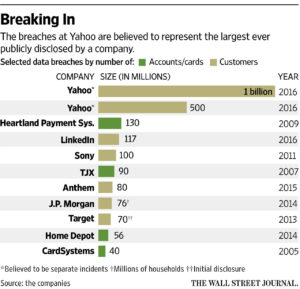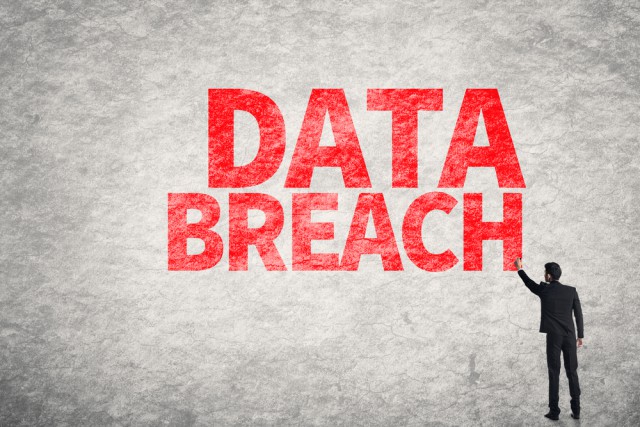Yahoo! just had the largest data breach of user information…AGAIN. 1 billion people users have had their information (name, password, email address, date of birth, telephone number and security questions) compromised. They now account for the 2 largest data and identity breaches in world history. Congratulations?

Largest Data Breaches (Compliments: The Wall Street Journal)
Security experts will tell you thieves only need approximately 4 pieces of personal information have a pretty good chance of stealing your identity. Marketers need even less. With a decent social hacking program, thieves can simply email individuals (by name) and state,
“Mr. Brian Patterson, We are Your Central Bank, and due to the recent string of cyber attacks we are bolstering our system and need to confirm your account number. If your address is still 11326 North Main Street in Happy, OH and your date of birth of 01/05/1952, could you please call 687.543.1234 and speak with our representative to confirm you information and protect your family? We apologize for this inconvenience and our technology experts are doing all they can to protect your assets.”
Yeah, this recent cyber attack is a pretty big deal. However, there are certain steps companies and consumers should do to protect themselves from identity theft and data breaches. Your data is your data and ultimately, you are responsible for keeping it safe. Here is what you can do:
- Password Managers – Some of the best password managers are 1Password, LastPass and Password Keeper. The good ones have AES-256 bit encryption and will automatically generate a password for user that is a random series of numbers, letters and symbols. You can even vary the length of the password (up to 40 characters). Make sure and change them every six months.
- Personal Information – Many times when I consult with professionals, if a website or social media channel asks them for information, they feel obligated to provide it. NOT NECESSARY. When you are registering for a sight to buy a pair of shoes, they don’t have to know your date of birth. Although it seems innocent enough, your date of birth is one of the key factors data thieves can use for identity theft and data breaches.
- Social Media Use – I love using social media, and I have built a company teaching brands how to use and managing social media effectively. Just like companies have social media guidelines, so should individuals. Sharing your date of birth, anniversary and information about your children on Facebook, Twitter and Instagram is a recipe for personal data disaster. Scientifically Speaking uses LinkedIn as a powerful tool to build and maintain relationships, but we guard our personal information like a vault.
- Credit Cards – Do not give your credit card to every website you see that has a low price on holiday sweaters. Just because you see a pop up add with a low price and a banner that says “Only 2 Left in Stock”, don’t be so quick to pull out the credit card. Only make purchases from reputable and well known sites with security built in (e.g. – Https:// is better than Http://).
- Be Smart – Your bank, the Internal Revenue Service (IRS) and financial investing firms don’t send emails asking consumers to confirm passwords, account information and credit card numbers. Do not fall prey to scams of a Facebook or LinkedIn “friend” who sends you an email asking for money because of a tragedy that has befallen their life. Take your time, think about the situation and investigate.
I like Yahoo! and I hate to see them with problems and challenges like a string data breaches. However, it is up to the consumer to use available tools to protect their personal data and information. Not everyone is going to able to set up a DNS server in their home with email hosting, RAID array, cloud synching and file sharing capability. Therefore, take the necessary steps to protect yourself and your online data and information.
Scientifically Speaking, of course




